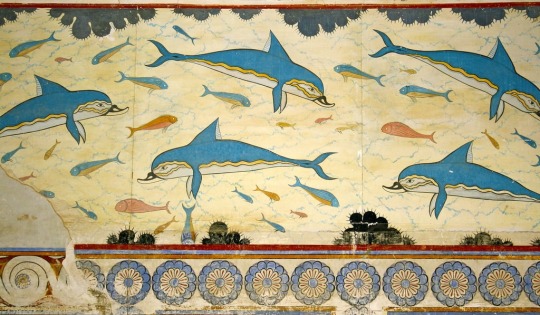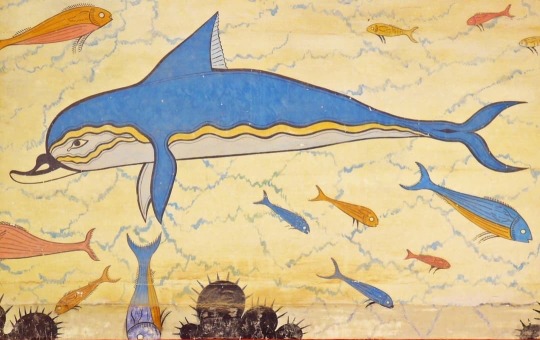#minoan civilization
Explore tagged Tumblr posts
Text

they lived, they served cunt, and then disappeared from history
#minoan#minoan civilization#pre-greek civilization#greek#memes#meme#classic memes#history#ancient greece#shitpost#mycenean#mycenean civilization#homer#the illiad#the odyssey#bronze age#ancient history#ancient world
1K notes
·
View notes
Text

Minoan bull-leaping girls
Art by capelinssm
579 notes
·
View notes
Text



Minoan frescoes. The 1600s BC was a great time for fashion.
#art#art history#ancient history#history#ancient greece#greece#frescoes#fresco painting#minoan#minoans#minoan civilization#bronze age#fashion#fashion history#history of fashion#ancient civilizations
2K notes
·
View notes
Text

The Toreador Fresco, Knossos Palace, Crete, c.1500 BC
#art#artistic#fresco#minoan civilization#ancient art#minoan crete#greece#ancient greece#knossos#crete
398 notes
·
View notes
Text


Dolphins Fresco, Palace of Knossos (& detail)
c. 1700-1450 B.C.
#knossos#fresco#dolphins#ancient art#antiquities#minoan civilization#minoan art#minoan#beautiful animals#nature#wildlife#beautiful dolphin#aesthetic#beauty#animals in art#art history#aesthetictumblr#ancient history#ancient world#tumblraesthetic#tumblrpic#tumblrpictures#tumblr art#tumblrstyle#artists on tumblr
2K notes
·
View notes
Text

go athenian boy go
#theseus#greek mythology#tagamemnon#art#drawing#artists on tumblr#digital art#mythology#athens#minotaur#theseus and the minotaur#asterion#minoan civilization#minoans#crete
196 notes
·
View notes
Text

A 3500-year-old Minoan octopus vase from Palaikastro. Now on display at the Heraklion Archaeological Museum in Crete, Greece.
via: American Institute of the Humanities
176 notes
·
View notes
Text

Dolphins inspired by Minoan frescoes.
References below the cut.

#tagamemnon#minoan#minoan crete#minoan civilization#bronze age#bronze age aegean#dolphin#dolphins#animal art#animal#sea#sea animals#marine biology#digital art#artist on tumblr#fresco painting
228 notes
·
View notes
Text

"The prominence of female divinity in Minoan culture might well have reflected the prominence of Minoan women in daily life. In Shang dynasty China, the authority of goddesses such as the Eastern and Western Mothers was echoed to some degree by the authority of women in elite society and even the army. Fu Jing and Fu Hao, wives of King Wu Ding, led men into battle before being honoured in death with monumental tombs containing the victims of human sacrifice, battle axes, knives and arrowheads. In Egypt, many of the images of Hatshepsut were destroyed or defaced after her death when her name was removed from the official list of rulers by her male successors, who sought to claim direct descent from her husband. It is possible that images of powerful Minoan women were subject to similar mistreatment.
While there is no evidence that Minoan women ruled in the same manner as Hatshepsut, or joined battle like the women of Shang China, the sheer number of artworks depicting them centrally placed and on a larger scale than men has prompted some historians to speculate that Minoan society was matriarchal or matrilineal. ‘Neopalatial Crete,’ writes one scholar, ‘presents the best candidate for a matriarchy – if one ever existed.’ There is nothing to say that the position of Minoan women was in any way secondary to that of men.
Minoan women were certainly not confined to the weaving room. Sculptures show them playing lyres, flutes and zithers, sashaying in flounced chevron-patterned skirts and raising their arms in the air in ecstasy. In the ‘Grandstand Fresco’ from Knossos the women are more carefully delineated in paint than the men. Each woman has her own identity, her own style. The women appear to occupy the main rooms of the palace while the men congregate as an anonymous mass beyond. Women depicted seated – a sign of divinity or authority – are often being approached by men or animals. A highly enigmatic fresco at Thera (Santorini), for example, features a woman wearing large hoop earrings, a snake in her hair, and a neck-chain of ducks, sitting on a dais with a griffin beside her while a blue monkey pays her court.
On a gold ring, a female deity, we may presume, is seated beneath a tree, where she receives flowers from two women. A smaller figure of a man with a double-headed axe over his head hovers between them. By depicting the man beneath the axe, and on a smaller scale than the women, the engraver of the ring perhaps hoped to convey that he was a divine vision, almost a thought-bubble, originating in one of the female worshipper’s heads. Trees, as Arthur Evans recognised, were sacred in Minoan culture, and were perhaps believed to be capable of inspiring divine visions in those who honoured them. Such artworks contribute to the picture of Minoan women exerting considerable religious authority in the palace complexes and society more widely.
Minoan women also played a crucial role in ritual. The early Minoans sometimes interred their dead twice by exhuming the bones of their family members and resettling them later in jars. The more usual custom, however, was to bury the dead in chamber tombs or stone beehive-shaped ‘tholos’ tombs, clay sarcophagi or, in the case of infants, under the floorboards of the home. The colourful paintings on a rare limestone sarcophagus from Hagia Triada, circa 1400 bc, show three men carrying young animals and a model boat to the deceased, who stands in front of his tomb, ready to receive his provisions for the afterlife. There are also three women present, the first of whom pours a libation into a cauldron placed between two upright axes mounted by birds; the second carries further vessels; the third – darker skinned like the men and thus possibly of lower social status – has a lyre. On the other side of the sarcophagus the women assist in the sacrifice of a bull on an altar. Other wall paintings show women involved in rituals of their own involving blood. A fresco from Akrotiri features a group of women, one of whom sits beside a sunken room or ‘lustral basin’ with a bleeding foot. A tree also bleeds. It is possible that lustral basins were used for purification by women during or after menstruation."
The Missing Thread: A Women's History of the Ancient World, Daisy Dunn
#history#women in history#women's history#historyedit#minoan women#minoan civilization#bronze age#crete#knossos#ancient history#ancient world#powerful women#historical figures
158 notes
·
View notes
Text




Agamemnon and Clytemnestra of Mycenae with their children Iphigenia, Orestes, Electra and Chrysothemis
L to R: Iphigenia, Agamemnon, Clytemnestra(holding Chrysothemis,) Orestes and Electra
CC by @clepysdra @mrsracooney and @kyriat-sims + many others
My design for Agamemnon, Clytemnestra, Iphigenia, and Orestes inspired by @kyleesarthell and @ejthepuca
#agamemnon#clytemnestra#iphigenia#epic the musical#homeric epics#orestes#electra#Iphigenia in Aulis#iphigenia 1977#greek mythology#homeric poems#mycenaean#mycenaean greece#minoan civilization#the iliad#tagamemnon
38 notes
·
View notes
Text



My redraws of famous Minoan wall paintings
#my art#minoan civilization#minoan#ancient Greece#art#illustration#historical illustration#historical redraws#bronze age#minoan crete#ancient crete#artists on tumblr#greek history
321 notes
·
View notes
Text


The Prince of lilies and a gryphon
Art by capelinssm
61 notes
·
View notes
Text

i just realized i havent posted any Minoan girl art on tumblr so here you go 🏺 (might need to turn your brightness up to see this one)
#artwork#didgitalillustration#my art#minoan#ancient greece#bronze age#ancient crete#minoan civilization#minoan crete#historical art#historical oc
154 notes
·
View notes
Text

a lion does not concern himself with the opinion of mycenaeans
43 notes
·
View notes
Text

Minoan civilization
47 notes
·
View notes
Text
Minoan Jewelry

Minoan jewelry is a stunning example of the intricate craftsmanship and advanced artistry of the Minoan civilization (3000–1450 BC), one of the earliest advanced cultures in Europe, flourishing on the island of Crete, Greece. 🇬🇷
The jewelry on display at the Archaeological Museum of Heraklion, located in Crete, offers a glimpse into the aesthetic and cultural significance of adornment in Minoan society.
The Minoans, known for their advanced metallurgy, created exquisite gold, silver, and bronze jewelry, often adorned with precious gemstones like amber, lapis lazuli, and coral.
The designs were not only beautiful but also held symbolic meaning, often related to gods, nature, and the afterlife.
Among the most remarkable pieces are the gold necklaces, earrings, bracelets, and finger rings, many of which are finely detailed with motifs such as animals, sea creatures, and geometric patterns.
The use of faience (a type of glazed ceramic) is also prominent in Minoan jewelry, adding color and vibrancy to pieces.
These artifacts provide insight into the social and religious practices of the Minoans, as jewelry was often used as a sign of wealth, social status, and divine favor.
The Archaeological Museum of Heraklion houses some of the most significant Minoan jewelry pieces, offering visitors a glimpse into the luxury and refinement of this ancient civilization.
The museum’s collection helps to contextualize these objects within the broader history of Minoan art, rituals and daily life, allowing us to appreciate the craftsmanship that has influenced jewelry design for millennia.
#Minoan#minoan civilization#jewelries#craftsmanship#artistry#Crete#Greece#ancient greece#ancient civilizations#Archaeological Museum of Heraklion#metallurgy#faience#artifacts#Minoans#jewelry design#symbolic meaning#aesthetic#culture#history#cultural significance
30 notes
·
View notes